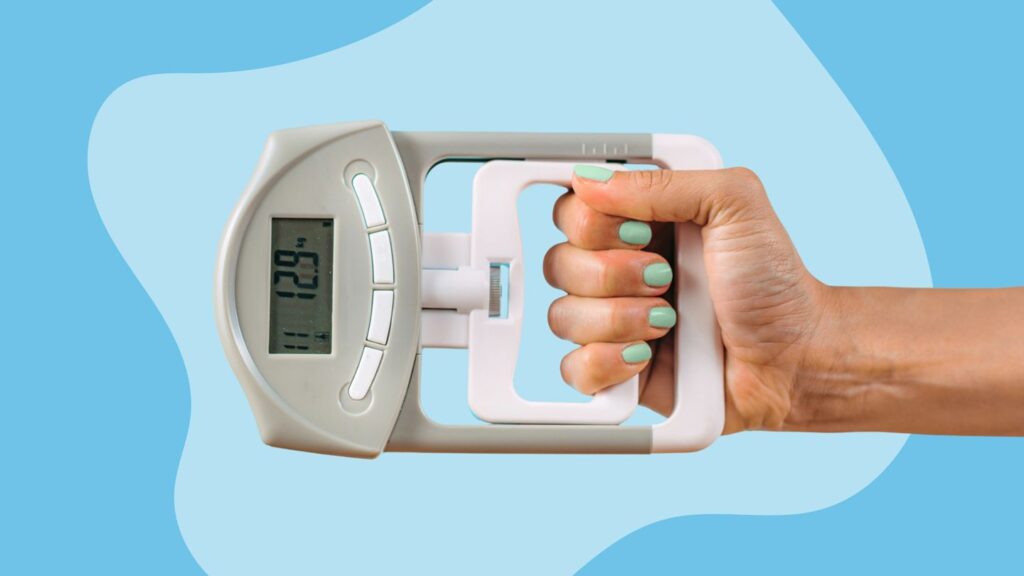If trouble with grip strength leaves you struggling to open a new jar of salsa, you may have an increased risk of chronic illness in your future, researchers have established.
The new findings suggest that a low grip strength is a powerful early sign of future issues related to excess weight, according to the authors, and that increasing muscle strength can help promote long-term health.
People With the Strongest Grips Were Least Likely to Die Over the Study Period
To explore the link between grip strength and the risk of developing obesity-related health problems such as heart disease, type 2 diabetes, and early death, researchers followed nearly 100,000 adults from the UK Biobank with “preclinical obesity” for about 13 years on average.
Preclinical obesity describes the period in which extra body fat is beginning to affect the body in unhealthy ways — but before any obesity-related diseases have developed or been diagnosed.
Grip strength was measured with a hand dynamometer, a device you squeeze as hard as possible. Then researchers split people into a few groups according to their sex and whether their grip strength was low, medium, or high.
After adjusting for many factors that could influence the results, such as age, sex, blood pressure, blood sugar, smoking, activity, diet, and medications, the investigators found:
- People in the group with the highest grip strength were less likely to die during the study period, compared with people in the weakest group.
- Higher grip strength was linked to a significantly lower risk of transitioning from having two or more obesity-linked conditions to a death related to heart disease or cancer.
This study reinforces the theory that stronger individuals are less likely to develop obesity-related health issues and have a lower risk of death from any cause, even after accounting for body weight, body fat, and other health factors, says Eric Angermeier, MD, an orthopedic hand and wrist surgeon and cofounder of the Hand Institute of Charleston in South Carolina.
“It suggests that grip strength, not just body size or BMI, is a key marker of metabolic health,” says Dr. Angermeier, who wasn’t involved in the study.
Low Muscle Strength Signals Poor Metabolism and Higher Inflammation
Why would having a weaker grip put you at higher risk of developing health issues related to obesity?
“Grip strength reflects how well the body’s muscles are functioning, which in turn influences metabolism, insulin sensitivity, and inflammation, all of which are critical in obesity-related diseases,” explains Angermeier.
People with lower muscle strength tend to have higher levels of inflammation and poorer blood sugar control, which can accelerate problems like liver disease, heart disease, and diabetes, he says.
“While excess fat contributes to disease, poor muscle function seems to make those risks even worse,” says Angermeier.
This study underscores a broader message: Muscle is medicine, he says. “In an era when obesity and metabolic disease are common, maintaining strength and muscle quality may be as important as managing weight,” says Angermeier.
Why Grip Strength Matters So Much
“Grip strength is a reliable indicator of overall strength and health because it is a simple, reproducible measure that correlates strongly with general muscle strength, physical function, and a wide range of health outcomes, including morbidity [disease] and mortality,” says Michael Fredericson, MD, a professor of orthopedic surgery and the codirector of the Stanford Longevity Center at Stanford Medicine in California.
The biological basis behind this link is that grip strength reflects not only the integrity of muscles throughout the body but also muscular control, diet quality, and overall body health, says Dr. Fredericson, who was not involved in the study.
“It is also linked to bone mineral density, risk of fractures, and quality of life. Because muscle strength declines with age, grip strength serves as a sensitive marker for early detection of frailty and health vulnerability,” he says.
- Chronic conditions such as heart disease, type 2 diabetes, and stroke
- Higher rates of hospitalization
- Longer hospital stays
- Poorer diet quality
These findings, along with existing evidence about grip strength, suggest that handgrip testing during routine visits to a healthcare provider could have several benefits, says Ryan McGrath, PhD, associate professor and researcher with a focus on aging and frailty at North Dakota State University in Fargo.
“Monitoring handgrip strength over time may help with observing changes, and the initiation of early intervention as appropriate,” says Dr. McGrath, who wasn’t involved in the study.
Could Improving Grip Strength Lower Your Risk of Chronic Disease?
While grip strength is a proxy, it’s a very good one, says Angermeier.
“The hands are uniquely sensitive to changes in the body’s neuromuscular and metabolic health, so declining grip strength may be an early sign of systemic weakness, inflammation, or frailty. In that sense, it’s both a convenient stand-in for overall vitality and an early warning signal of declining health,” he says.
While scientists don’t yet have definitive proof that improving grip strength itself directly reduces disease risk, evidence strongly suggests that maintaining or building muscular strength through resistance training and physical activity has lots of benefits for metabolic health, says Angermeier.
“Regular strength training lowers blood pressure, improves insulin sensitivity, reduces inflammation, and helps preserve healthy body composition. So, while grip strength itself may just be the measurable marker, the actions that improve it are clearly protective,” he says.
Tips for Improving Your Grip Strength
If you want to improve your grip strength, any consistent strength training that challenges the muscles of the hands, forearms, and upper body will help, says Angermeier.
Simple options include:
- Using hand grippers or squeezing a stress ball
- Lifting weights, especially with exercises like deadlifts, rows, pull-ups, or farmer’s carries
- Sports such as rock climbing or rowing
- Heavy yard work
“The key is consistency, training major muscle groups at least twice a week, and staying physically active every day,” Angermeier says.
Read the full article here


